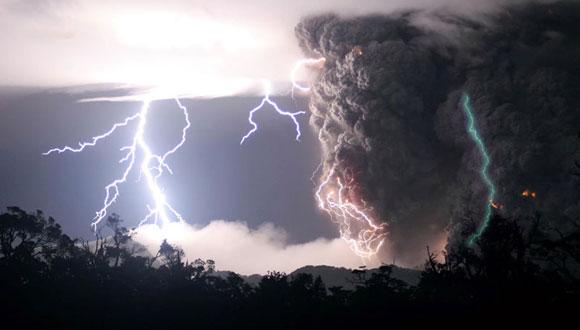Research Field - Atmospheric Sciences
Atmospheric Science deals with the physical and chemical processes occurring in the envelope of air surrounding the Earth. Research in atmospheric science uses a wide array of methods to describe and understand the phenomenon observed in our atmosphere, including clouds, rain, weather, climate, severe weather, El Nino, etc. The data for analysis of such phenomenon are obtained from instruments on the surface, balloons and planes in the atmosphere, and satellites observing from space. Using super computers these data help develop mathematical models that are used for weather and climate forecasts. These observations and models allow us to study many different natural phenomenon, some at the forefront of public interest: climate change, global warming, the ozone hole, air pollution, weather forecasting, El Nino, severe weather, hurricanes, etc. In addition, applications are related to weather forecasting for aviation (military and civilian), public health, and early warning of natural hazards such as flash floods, hurricanes, tornadoes, hail storms, etc.
Climate
The climate is defined as the long term statistics of the atmosphere and weather. For example: temperature changes, rainfall amount, and the frequency of storms. In our department we perform analysis on climatic data sets to study the changes that have occurred over the last decades. We also run climate models to try to understand how the climate may change in the future under the influence of global warming.
Meteorology
Meteorology, or the study of the weather, deals with the faster changes in the atmosphere on time scales of minutes to days. In our department we study the physics behind weather predictions, and run models that can predict the weather. Meteorology can be divided into three branches: physical, synoptic and dynamic meteorology.
Physical Meteorology
This branch deals with the structure and composition of the atmosphere, radiative transfer, acoustic waves in the atmosphere, aerosols, cloud and rain formation, atmospheric electricity (lightning), weather modification (cloud seeding), and observational methods like radar, satellites and lidar.
Synoptic Meteorology
This branch deals with weather forecasting. Describing, analysing and forecasting the motions in the atmosphere on the large scale, using observations and models. Surface and satellite data are merged with numerical models to help improve weather forecasting.
Dynamic Meteorology
This branch deals with the theoretical description of the atmospheric flows (winds) and their development over time. A system of fundamental equations describing the motion of the atmosphere is used to describe the flow of air in the atmosphere on all spatial and temporal scales. These equations are the building block of the models used to predict the weather and climate in the future. Good weather forecasts are a result of merging synoptic and dynamic meteorology.
Upper Atmosphere
At altitudes above 20 km the physics of the atmosphere changes. In the lower atmosphere (troposphere) thermodynamics is the key driver of the processes of weather and climate, while above 20km (stratosphere, mesosphere, thermosphere) the Sun is the main driver of the atmosphere. The ozone layer is found around 20-30km altitude, and is important for blocking out harmful UV radiation from the Sun. Above 70km the gases are ionized by the Sun's radiation, forming a plasma layer we call the ionosphere. This is important for the propagation of radio waves around the globe for communications. Above about 100km we enter the realm of space.
Researchers:
Prof. Pinhas Alpert (Emeriti)
Weather forecasting including advanced atmospheric models and developing of numerical techniques. Investigation of extreme Weather events - their causes and effects using both observations and models. Climate changes and their impacts on the Mediterranean employing observations and various climate models. Investigation of different atmospheric aerosols employing observations along with global & regional models. Regional NASA center for the Earth observations. Study of the Dead-Sea climate.
Geophysical fluid dynamics, Submesoscale dynamics, Wave-current interactions, Upper ocean processes
Theory of Fluid Dynamics, Atmospheric and Oceanic Fluid Dynamics, Evolution of Geophysical Shear Flows, Wave and Mean Flow Interaction and Instability
The atmospheric patterns of wind, pressure, and temperature, and their temporal variations, influence our daily lives through the changes in weather, and on seasonal and longer time scales, through changes in climate conditions. The global circulation of the atmosphere, which consists of a few different regions, is one of the main features determining the climate zones on Earth. Understanding the circulation of the atmosphere, and the ability to simulate it numerically and predict the weather, have advanced greatly in the past half century or so. The vast growth of data from these efforts has strengthened our need for a fundamental physical understanding of this circulation, in particular, it is important to understand its natural variability, in relation to the response to external forcing and man made changes.
Research in my group centers on developing an understanding of the main atmospheric wind and temperature patterns, their natural variations and response to different forms of forcing, on daily, seasonal, annual and longer time scales.
Main current projects: The contribution of the atmospheric circulation to extreme weather events; The maintenance and variability of different global circulation regimes; Stratospheric planetary waves, their interaction with ozone, and the downward coupling to the troposphere; The role of upper level outflow in hurricane evolution.
Atmosphere Electricity- lightning, thunderstorms, sprites, meteors. Electromagnetic waves in the atmosphere in the frequency ranges of ULF, ELF and VLF. Global and regional climate change, global warming, El Nino, atmospheric chemistry, biomass burning, earthquakes, Big Data.
Modeling and forecast of Saharan dust transport over the Mediterranean, the Middle East, Europe, and over the Atlantic Ocean. Modeling of space-time distribution of marine aerosols over the Mediterranean Sea and their effects on the Eastern Mediterranean weather and climate. Global distribution and trends of aerosols using satellite data and ground-based measurements. Study of the Dead Sea aerosols and their effects on atmospheric radiation and Dead Sea water temperature.
Observation and monitoring of Space Weather in Hermon mountain at the Cosmic Ray and Space Weather Emilio Segre Observatory. Influence of Cosmic Ray from the solar flares and from Supernova explosions on the Earth environment (magnetosphere, ionosphere, high atmosphere).


